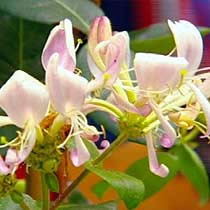
The word zimolez, which is honeysuckle in Czech, came up the other day during a conversation with a Czech friend. It comes from zima (winter) and lézt (to climb, crawl, creep), so could be translated as “winter climber”.
Other interesting words that came up include plšík (doormouse), smršť (tornado) brblat (to grizzle, beef, grouch, mutter) and žbrblat (to mutter to oneself). The root smršť also appears in words related to shrinking and contracting, such as smrštit (to shrink), smrštěný (contracted, shrunk) and smršťovací fólie (shrink wrap).
What delicious consonant clusters!
The English name honeysuckle comes from the Old English hunigsuge (honey-suck). An alternative name is Eglantine, which comes from the Old French aiglent (dog rose), from the Vulgar Latin aquilentus (rich in prickles), from the Latin aculeus (spine, prickle), a diminutive of acus (needle)
Names for honeysuckle in other languages include:
- German: Geißblatt (goat leaf)
- French: Chèvrefeuille (goat leaf)
- Irish: Féithleann (vein ale ?)
- Italian: Caprifoglio (goat leaf)
- Latin: Lonicera
- Spanish: Madreselva (mother jungle)
- Welsh: Gwyddfid (wild hedge ?) or Llaeth y gaseg (mare’s milk)
Kamperfoelie! The most divine fragrance in the world.
I love this in Spanish ‘Spanish: Madreselva (mother jungle)’ – perfect description for how the flower looks and I love the smell. Not sure how goat comes into it though….
It’s жимолость (zhimolost’) in Russian, clearly sharing roots with the Czech word.
According to my Czech etymological dictionary, smršť and smrštit have different origins. The latter, together with words mrštit (to throw), mrskat (to lash, to flog), smrsknout (iterative form of mrštit), mrštný (quick, lithe) is from Old Slavic mъrskati (to blink, to flash). The former, smršť, is borrowing from Russian смерч, which evolved from Old Slavic *morkъ (cloud, dark), and Czech cognates are mrak (cloud) or soumrak (dusk). However, both roots ultimately trace back to PIE *mer (=flash).
Interestingly enough, Etymonline doesn’t support my hypothesis of the common origin of these words with English murky:
http://www.etymonline.com/index.php?term=murk
Moreover, Russian жимолость is interesting, because it points to the possibility that the Czech form is influenced by a folk etymology, and the true origin has nothing to do with winter (or cold, which is the second meaning of zima) and creeping. Unfortunately, my dictionary is silent about zimolez.
And by the way, there is another similar Czech name, zimostráz (boxwood, lat. buxus).
According to the Russian etymology (Vasmer) I googled, it’s likely from Polish ‘zimoɫza’, where, and I quote:
“ži- < *ghei-d- "козленок", ср. нов.-в.-н. Geiss "коза", лат. haedus, а -molztь, -ml̥zа – из слав. ml̥zǫ "дою, сосу", откуда первонач. знач.: "козлячье горлышко"
It concludes that a loose translation of the word would be "goat's little throat". Sorry, no time to de-abbreviate, translate the above.
I’m pretty sure that eglantine isn’t an alternative name for honeysuckle? Woodbind is another name for honeysuckle while eglantine is better known as sweetbrier (drysïen bêr/miaren Mair) a member of the Eurasian rose family (Rosa rubiginosa). Didn’t you seem it odd considering honeysuckle’s obvious lack of thorns and prickles?
Oops typo – woodbine.
In (modern) Polish is wiciokrzew (or suchokrzew).
The first means either ‘running shrub’ or ‘plaited shrub’ (there’s more than one plausible meaning of wić) while the less common suchokrzew means ‘dry shrub’.
*as in ‘runner’ a kind of plant
“it’s likely from Polish ‘zimoɫza’ … “goat’s little throat””
Actually zimołza looks just like the Czech with a slightly different vowel distribution
zim- winter
-o- element connector with no inherent meaning
łza (from łazić, dawdle, loiter, be in a place or climb)
Theoretically -łza could also be tear (from crying) but that seems less likely.
In addition to Drabkikker’s post, I can add that the Dutch name “kamperfoelie” is derived from the Italian name “caprifoglio”, meaning “goat leaf”.
I had the same reaction as Yenlit when reading the article. No way the eglantine (dog rose, as you said, http://en.wikipedia.org/wiki/Eglantine_rose) is the same as honeysuckle (http://en.wikipedia.org/wiki/Honeysuckle)!
I remember pulling the stems with the nectar on them out and eating it (the nectar, not the stems) as a kid 🙂
Andrew, I had completely forgotten about doing that! Now I’m a grown-up, I eat sweet, spicy monarda flowers…
@ Jerry:
Correct. I’m told that an alternative name is geitenblad “goat leaf”, although I’ve never heard anyone call it that.
An interesting feature is the nasalisation that took place in the process from caprifoglio to kamperfoelie. I guess the word kamp “field” has been of influence there. Foelie, amongst others, is the Dutch word for mace (the stuff that grows around nutmeg), but I’m pretty sure that’s a loanword as well.
Dutch ‘foelie’ is probably from Latin “folium”?
@ Yenlit:
Doubtlessly. Ah, yes, by means of Old French, so the Dutch Etymology Dictionary tells me.